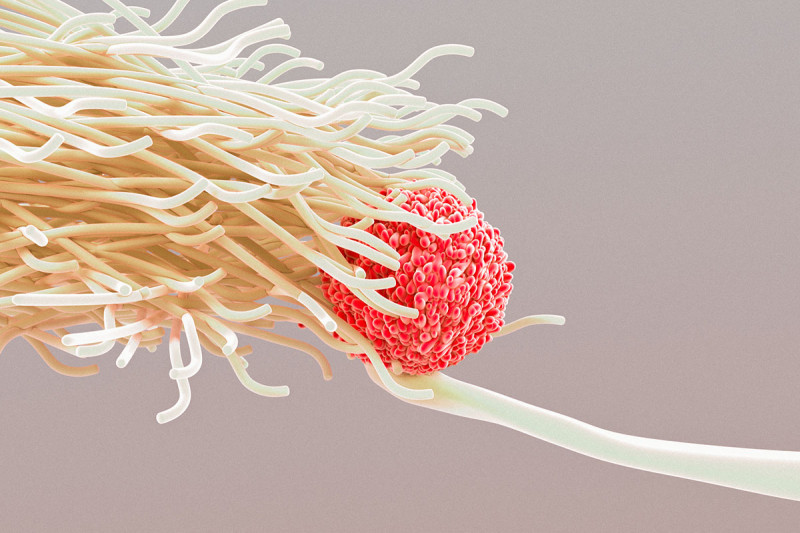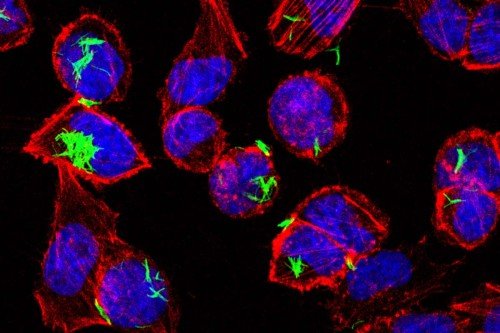
Dendritic cells (white) detect foreign invaders and alert other immune cells (red) to the presence of danger.
Biologists sometimes liken the immune system to an army defending territory. From the infantry on the front lines to special forces that parachute in, diverse groups of soldiers cooperate in defensive maneuvers.
Central to this multifaceted operation by the immune system are dendritic cells. Found throughout the body, these cells serve as guards on the lookout for suspicious activity. When any is found, dendritic cells sound an alarm to alert other cells and call in reinforcements.
For many years after their discovery in the 1970s, dendritic cells were considered by scientists to be all of apiece. But researchers are beginning to understand that these critical actors have a complex division of labor of their own.
In a study published October 24 in the journal Cell, Sloan Kettering Institute immunologist Alexander Rudensky and colleagues report the discovery of two previously unknown dendritic cell subtypes. They play opposing roles in immune responses and could help explain some long-standing mysteries about the immune system, such as why some people with cancer respond to immunotherapies while others do not.
“Dendritic cells are the gatekeepers of immune responses,” says Dr. Rudensky, Chair of the Immunology Program at SKI and Director of the Ludwig Center for Cancer Immunology at Memorial Sloan Kettering. “With the discovery of these dendritic cell subsets, we now have a framework for establishing how these cells promote different immune responses and what might go wrong in the context of diseases.”
Seeing the Trees through the Forest
Before this study, scientists divided dendritic cells into two buckets: classic dendritic cell 1 (cDC1) and classic dendritic cell 2 (cDC2). The former is a clearly defined grouping of obviously similar cells but the latter somewhat more of a grab bag.
“We didn’t really have the tools to look at the cDC2 subset in a way that allowed us to divide it up coherently,” says Chrysothemis Brown, a physician-scientist working as a postdoctoral fellow in Dr. Rudensky’s lab and the paper’s co-first and co-corresponding author.
What allowed scientists to further classify cDC2 cells is single-cell RNA sequencing (scRNA-seq). This powerful technique can detect what genes are turned on in thousands of individual cells at the same time. Alongside Herman Gudjonson, a co-first author and a postdoctoral fellow in Dana Pe’er’s lab at SKI, the team performed scRNA-seq on nearly 4,500 dendritic cells obtained from mice. These results identified two distinct subtypes of cDC2 cells, now classified cDC2A and cDC2B, bringing the total number of dendritic cell types to three.
“Whereas previously we only had the ability to see a uniform forest, our findings now reveal the different trees within that forest,” Dr. Rudensky says.
Surprising Parallels
Remarkably, the split in dendritic cell subtypes mirrors other divisions in the immune system. T cells, for example, are typically divided into CD8+ “killer” T cells and CD4+ “helper” T cells. The latter are further subdivided into Th1, Th2, and Th17 cells. Each has distinct proinflammatory qualities designed to counter different challenges.
Dendritic cells too, these news results show, share a similar division of labor. The cDC1 subset alerts CD8+ T cells, while cDC2A and cDC2B control different immune responses. On the whole, cDC2A cells are directed more toward tissue healing, while cDC2B cells are more inflammatory.
Even more striking, the same molecular cues that establish the division in T cells (in particular, a protein called T-bet) control the development of the dendritic cell subtypes.
“It’s a remarkable parallel between the main branches of the immune system,” Dr. Rudensky says. “It suggests a possibility that different immune cell types are able to communicate with each and form regulatory circuits through these common mechanisms.”
Relevance to Disease
The researchers performed their initial studies in mice but extended them to humans. They found that human dendritic cells can be grouped into the same three divisions. This suggests that results from experiments done in mice will be translatable to humans.
The new dendritic cell categorization could have particular relevance to cancer. Tumors are known to co-opt the immune system in ways that make it less inflammatory and more geared to tissue repair. This could mean that cDC2A cells are playing an important role in sustaining tumor growth. Indeed, the team found these cells in samples of melanoma tumors obtained from patients.
“This heterogeneity among dendritic cells might explain some of the differences we see in patients in terms of tumor progression and response to immunotherapy,” Dr. Brown says. “Now that we have the ability to detect these cells and the tools to target them in models of disease, we can start to address these questions.”



